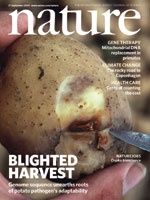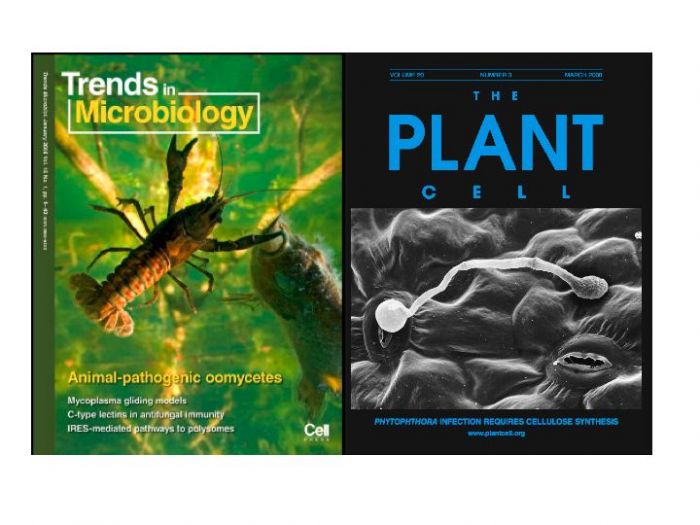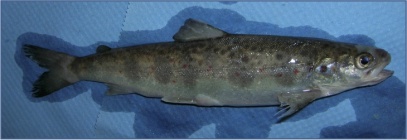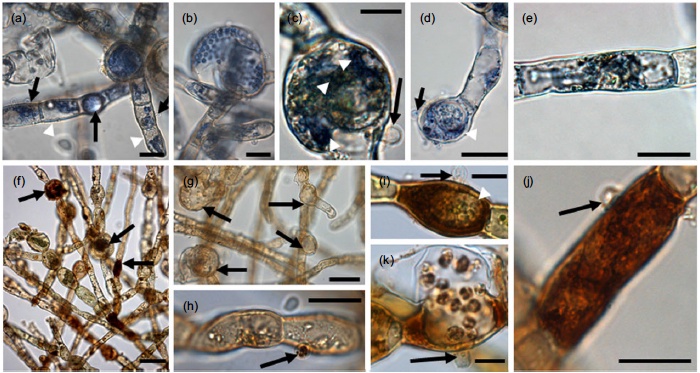
MSc (Wageningen, The Netherlands, 1993) PhD (Wageningen, The Netherlands, 2000)
Chair in Mycology
- About
-
- Email Address
- p.vanwest@abdn.ac.uk
- Telephone Number
- +44 (0)1224 437327
- Office Address
Office 2:33, Lab 2:39
Aberdeen Oomycete Laboratory
College of Life Sciences and Medicine
Institute of Medical Sciences
Foresterhill
Aberdeen
AB25 2ZD- School/Department
- School of Medicine, Medical Sciences and Nutrition
Biography
Prof. Dr. Ir. Pieter van West is a past Royal Society University Research Fellow. He is Director of the International Centre for Aquaculture Research and Development (ICARD) at the University of Aberdeen, Board member of the Sustainable Aquaculture Innovation Centre (SAIC), Fellow of the Royal Society of Edinburgh and he was President of the British Mycological Society 2017-2018) .
His current research programme focuses on oomycete biology. Several economically and environmentally important oomycetes, or watermoulds, are studied at most disciplinary levels (taxonomy, ecology, epidemiology, biochemistry and cellular and molecular biology and especially host-microbe interactions). He is particularly interested in developing novel methods to control oomycete pathogens.
The animal pathogenic oomycetes under investigation are Saprolegnia parasitica, Saprolegnia australis, Saprolegnia diclina, Aphanomyces spp. and Halioticida spp.
The plant pathogenic species include mainly Phytophthora infestans and several Pythium spp. and the algal pathogenic species include Eurychasma dicksonii, Olpidiopsis spp., Anisolpidium spp. and Maulinia spp.
Memberships and Affiliations
- Internal Memberships
-
Director of the International Centre for Aquaculture Research and Development (ICARD)
- External Memberships
-
Fellow of the Royal Society of Edinburgh
Board member of the Sustainable Aquaculture Innovation Centre (SAIC)
Past President of the British Mycological Society
Editorial Board member of Fungal Biology
Editorial Board member of Fungal Biology Reviews
- Research
-
Research Overview
Fundamental molecular processes in Oomycete pathogens
The group of oomycete pathogens cause destructive diseases of thousands of (commercially important) plant species and fish. These so-called watermoulds have many fungus-like characteristics, but are not true-fungi. In fact, they are closely related to kelp and diatoms.
One particular oomycete, Phytophthora infestans, the causal agent of potato late blight, generates global yield losses estimated to exceed over £3 billion annually, making it one of the most important biotic constraints to global food production. It is probably the most destructive plant pathogen in human history, as it caused tremendous human suffering in the mid 1840's due to failed potato crops in Ireland and the UK.
One of the most destructive oomycete pathogens on fish is Saprolegnia parasitica. It is endemic to all fresh water habitats around the world and is partly responsible for the decline of natural populations of salmonids and other fresh water fish. Today, losses in the salmon aquaculture business in Scotland alone are estimated at several millions of pounds annually.

Despite their economic importance, little is known about the molecular mechanisms accounting for the success of Oomycetes as plant or fish pathogens, or the fundamental molecular processes underlying their development. My research program aspires to identify molecular characteristics that are essential for the development and pathogenesis of Phytophthora, Pythium and Saprolegnia species.
Work mainly focuses on the isolation and functional characterisation of genes encoding recognition molecules and stage-specific proteins to enable
- understanding and unravelling fundamental molecular processes in Oomycetes
- the detection of molecular targets for novel control strategies, possibly directed against a variety of Oomycete pathogens.

Current Research
1 Identification and functional characterisation of zoospore specific proteins from oomycetes via genomic, transcriptomic and proteomics approaches (Figure 1).

Figure 1. Zoospores are released from a sporangium of Saprolegnia parasitica (taken from van West, 2006)
2 Identification and functional characterisation of proteins from Saprolegnia parastica, a fish pathogen of salmonids and other fresh water fish (Figure 2), that are essential for development and pathogenicity.

Figure 2. Saprolegnia infection on pre-smolt salmon.
3 Investigating the mechanism of Phytophthora and Saprolegnia protein translocation into the host cells (Figure 3).

Figure 3 Oomycete effector translocation (Image taken from Wawra et al., 2012 Current Opinion in Microbiology doi:10.1016/j.mib.2012.10.008).
4 Research into oomycete-insect interactions

Figure 4 Saprolegnia infections of waterborne insects (Image taken from Sarowar et al. 2013 Fungal Biology 117: 752-763).
5 Research into oomycete-algae interactions.

Figure 5 Eurychasma infections in Ectocarpus (Image taken from Strittmatter et al., 2015, Plant Cell & Environment doi: 10.1111/pce.12533).
6 Discovering and describing novel oomycete species

Figure 6 Oospores of Pythium polare, a pathogen of moss from the arctic and antarctic regions (Image taken from Tojo et al. 2012, Fungal Biology doi:10.1016/j.funbio.2012.04.005).
- Teaching
-
Teaching Responsibilities
Eukaryotic Microbiology lectures in course BI25M5 (Microbes, Infection & Immunity)
Molecular Plant Pathology lectures in course AG3816 (Biology and Ecology of Plant Disease)
- Publications
-
Page 1 of 3 Results 1 to 50 of 128
Prevalence and seasonal variation of Olpidiopsis porphyrae (Oomycota) infecting red algal Bangiales from the Southern Pacific
European journal of phycology, vol. 59, no. 4, pp. 436-445Contributions to Journals: Articles- [ONLINE] DOI: https://doi.org/10.1080/09670262.2024.2383980
- [ONLINE] View publication in Scopus
Saprolegnia parasitica
Fish Parasites: A Handbook of Protocols for their Isolation, Culture and Transmission. CABI International, pp. 390-401, 12 pagesChapters in Books, Reports and Conference Proceedings: Chapters- [ONLINE] DOI: https://doi.org/10.1079/9781800629127.0026
- [ONLINE] View publication in Scopus
Rediscovery of the rare Cladochroa chnoosporiformis Skottsberg from the Falkland Islands and its merger with Utriculidium durvillei Skottsberg
Botanica MarinaContributions to Journals: ArticlesMacroalgal eukaryotic microbiome composition indicates novel phylogenetic diversity and broad host spectrum of oomycete pathogens
Environmental Microbiology, vol. 26, no. 6, e16656Contributions to Journals: ArticlesSpecific Phylotypes of Saprolegnia parasitica Associated with Atlantic Salmon Freshwater Aquaculture
Journal of Fungi, vol. 10, no. 1, 57Contributions to Journals: ArticlesAdvancements, deficiencies, and future necessities of studying Saprolegniales: A semi-quantitative review of 1073 published papers
Fungal Biology Reviews, vol. 46, 100319Contributions to Journals: Review articlesEvidence of a Natural Hybrid Oomycete Isolated from Ornamental Nursery Stock
Journal of Fungi, vol. 9, no. 6, 627Contributions to Journals: ArticlesDiseases and disorders in fish due to harmful algal blooms
Climate Change on Diseases and Disorders of Finfish in Cage Culture. Woo, P. T. K., Subasinghe, R. P. (eds.). 3 edition. CABI International, pp. 387-429, 43 pagesChapters in Books, Reports and Conference Proceedings: Chapters- [ONLINE] DOI: https://doi.org/10.1079/9781800621640.0010
- [ONLINE] View publication in Scopus
The molecular dialog between oomycete effectors and their plant and animal hosts
Fungal Biology Reviews, vol. 43, 100289Contributions to Journals: Review articlesSurvival of Phytophthora cryptogea and Phytophthora cactorum in Commercial Potting Substrates for Eucalyptus globulus Plants
Agriculture (Switzerland), vol. 13, no. 3, 581Contributions to Journals: ArticlesImpact of abiotic factors and husbandry on saprolegniosis in salmonid farms
Aquaculture, vol. 561, 738679Contributions to Journals: ArticlesCurrent practices and emerging possibilities for reducing the spread of oomycete pathogens in terrestrial and aquatic production systems in the European Union
Fungal Biology Reviews, vol. 40, pp. 19-36Contributions to Journals: Articles- [ONLINE] DOI: https://doi.org/10.1016/j.fbr.2021.10.001
Can Ulcerative Dermal Necrosis (UDN) in Atlantic salmon be attributed to ultraviolet radiation and secondary Saprolegnia parasitica infections?
Fungal Biology Reviews, vol. 40, pp. 70-75Contributions to Journals: Review articlesTransformation systems, gene silencing and gene editing technologies in oomycetes
Fungal Biology ReviewsContributions to Journals: Review articles- [ONLINE] DOI: https://doi.org/10.1016/j.fbr.2021.11.001
- [ONLINE] View publication in Scopus
Phylogenetic and Functional Diversity of Saprolegniales and Fungi Isolated from Temperate Lakes in Northeast Germany
Journal of Fungi, vol. 7, no. 11, 968Contributions to Journals: ArticlesEvaluation of potential transfer of the pathogen Saprolegnia parasitica between farmed salmonids and wild fish
Pathogens, vol. 10, no. 8, 926Contributions to Journals: ArticlesPathogenicity and Host Range of Pythium kashmirense: a soil-borne oomycete recently discovered in the UK
Journal of Fungi, vol. 7, no. 6, 479Contributions to Journals: ArticlesDevelopment of a 3D spheroid cell culture system from fish cell lines for in vitro infection studies: Evaluation with Saprolegnia parasitica
Journal of Fish Diseases, vol. 44, no. 6, pp. 701-710Contributions to Journals: Articles- [ONLINE] DOI: https://doi.org/10.1111/jfd.13331
- [ONLINE] View publication in Scopus
Transcriptome analysis reveals immune pathways underlying resistance in the common carp Cyprinus carpio against the oomycete Aphanomyces invadans
Genomics, vol. 113, no. 1P2, pp. 944-956Contributions to Journals: Articles- [ONLINE] DOI: https://doi.org/10.1016/j.ygeno.2020.10.028
- [ONLINE] View publication in Scopus
The chaperone Lhs1 contributes to the virulence of the fish-pathogenic oomycete Aphanomyces invadans
Fungal Biology, vol. 124, no. 12, pp. 1024-1031Contributions to Journals: Articles- [ONLINE] DOI: https://doi.org/10.1016/j.funbio.2020.09.003
- [ONLINE] View publication in Scopus
Molecular insights into the mechanisms of susceptibility of Labeo rohita against oomycete Aphanomyces invadans
Scientific Reports, vol. 10, 19531Contributions to Journals: ArticlesSaprolegnia infection after vaccination in Atlantic salmon is associated with differential expression of stress and immune genes in the host
Fish & Shellfish Immunology, vol. 106, pp. 1095-1105Contributions to Journals: ArticlesHost and pathogen autophagy are central to the inducible local defences and systemic response of the giant kelp Macrocystis pyrifera against the oomycete pathogen Anisolpidium ectocarpii
New Phytologist, vol. 226, no. 5, pp. 1445-1460Contributions to Journals: Articles- [ONLINE] DOI: https://doi.org/10.1111/nph.16438
- [OPEN ACCESS] http://aura.abdn.ac.uk/bitstream/2164/13982/1/Murua_HostAndPathogenAuophagy_VOR.pdf
- [ONLINE] View publication in Scopus
Morphological, genotypic and metabolomic signatures confirm interfamilial hybridization between the ubiquitous kelps Macrocystis (Arthrothamnaceae) and Lessonia (Lessoniaceae)
Scientific Reports, vol. 10, 8279Contributions to Journals: ArticlesThe influence of depth and season on the benthic communities of a Macrocystis pyrifera forest in the Falkland Islands
Polar Biology, vol. 43, pp. 573-586Contributions to Journals: Articles- [ONLINE] DOI: https://doi.org/10.1007/s00300-020-02662-x
- [ONLINE] View publication in Scopus
Biological Concepts for the Control of Aquatic Zoosporic Diseases
Trends in Parasitology, vol. 35, no. 7, pp. 571-582Contributions to Journals: Articles- [ONLINE] DOI: https://doi.org/10.1016/j.pt.2019.04.003
- [ONLINE] View publication in Scopus
- [ONLINE] View publication in Mendeley
Exophiala angulospora infection in hatchery reared lumpfish (Cyclopterus lumpus) broodstock
Journal of Fish Diseases, vol. 42, no. 3, pp. 335-343Contributions to Journals: ArticlesThe fungal ecology of seabird nesting sites in the Falkland Islands indicates a niche for mycoparasites
Fungal Ecology, vol. 36, pp. 99-108Contributions to Journals: ArticlesCell entry of a host targeting protein of oomycetes requires gp96
Nature Communications, vol. 9, pp. 1-12Contributions to Journals: ArticlesAphanomyces invadans, the causal agent of Epizootic Ulcerative Syndrome, is a global threat to wild and farmed fish
Fungal Biology Reviews, vol. 32, no. 3, pp. 118-130Contributions to Journals: Articles- [ONLINE] DOI: https://doi.org/10.1016/j.fbr.2018.05.002
- [OPEN ACCESS] http://aura.abdn.ac.uk/bitstream/2164/12287/1/Aphanomyces_final_accepted.pdf
- [ONLINE] View publication in Scopus
Galleria melonella as an experimental in vivo host model for the fish-pathogenic oomycete Saprolegnia parasitica
Fungal Biology, vol. 122, no. 2-3, pp. 182-189Contributions to Journals: ArticlesSpecialized attachment structure of the fish pathogenic oomycete Saprolegnia parasitica
PloS ONE, vol. 13, no. 1, e0190361Contributions to Journals: ArticlesMaullinia braseltonii sp. nov. (Rhizaria, Phytomyxea, Phagomyxida): A Cyst-forming Parasite of the Bull Kelp Durvillaea spp. (Stramenopila, Phaeophyceae, Fucales)
Protist, vol. 168, no. 4, pp. 468-480Contributions to Journals: Articles- [ONLINE] DOI: https://doi.org/10.1016/j.protis.2017.07.001
- [OPEN ACCESS] http://aura.abdn.ac.uk/bitstream/2164/9196/1/Protist.pdf
Hook, Line and Infection: A Guide to Culturing Parasites, Establishing Infections and Assessing Immune Responses in the Three-Spined Stickleback
Advances in Parasitology, vol. 98, pp. 39-109Contributions to Journals: Articles- [ONLINE] DOI: https://doi.org/10.1016/bs.apar.2017.07.001
- [ONLINE] View publication in Scopus
The RxLR Motif of the Host Targeting Effector AVR3a of Phytophthora infestans Is Cleaved Before Secretion
The Plant Cell, vol. 29, no. 6, pp. 1184-1195Contributions to Journals: Articles- [ONLINE] DOI: https://doi.org/10.1105/tpc.16.00552
- [OPEN ACCESS] http://aura.abdn.ac.uk/bitstream/2164/8946/1/the_RxLR_Motif.pdf
Isolation of fungal pathogens from eggs of the endangered sea turtle species Chelonia mydas in Ascension Island
Journal of the Marine Biological Association of the United Kingdom, vol. 97, no. 4, pp. 661-667Contributions to Journals: Articles- [ONLINE] DOI: https://doi.org/10.1017/S0025315416001478
- [ONLINE] View publication in Scopus
Marine benthic algal flora of Ascension Island, South Atlantic
Journal of the Marine Biological Association of the United Kingdom, vol. 97, no. 4, pp. 681-688Contributions to Journals: ArticlesNovel lineage of a green alga and Acremonium stroudii (Ascomycota) sp. nov. reported from Ascension Island
Journal of the Marine Biological Association of the United Kingdom, vol. 97, no. 4, pp. 669-679Contributions to Journals: Articles- [ONLINE] DOI: https://doi.org/10.1017/S0025315415001289
Emerging oomycete threats to plants and animals
Philosophical Transactions of the Royal Society B: Biological Sciences, vol. 371, no. 1709, 20150459Contributions to Journals: Articles- [ONLINE] DOI: https://doi.org/10.1098/rstb.2015.0459
- [OPEN ACCESS] http://aura.abdn.ac.uk/bitstream/2164/9495/1/RSTB20150459_2_.pdf
Nonagonal cadherins: A new protein family found within the Stramenopiles
Gene, vol. 593, no. 1, pp. 64-75Contributions to Journals: Articles- [ONLINE] DOI: https://doi.org/10.1016/j.gene.2016.08.003
Arctic marine phytobenthos of northern Baffin Island
Journal of Phycology, vol. 52, no. 4, pp. 532-549Contributions to Journals: ArticlesMobilization of Pollutant-Degrading Bacteria by Eukaryotic Zoospores
Environmental Science & Technology, vol. 50, no. 14, pp. 7633-7640Contributions to Journals: Articles- [ONLINE] DOI: https://doi.org/10.1021/acs.est.6b00994
- [OPEN ACCESS] http://aura.abdn.ac.uk/bitstream/2164/8971/1/acs_2Eest_2E6b00994.pdf
A thicker chorion gives ova of Atlantic salmon (Salmo salar L.) the upper hand against Saprolegnia infections
Journal of Fish Diseases, vol. 39, no. 7, pp. 879-888Contributions to Journals: Articles- [ONLINE] DOI: https://doi.org/10.1111/jfd.12421
NmPin from the marine thaumarchaeote Nitrosopumilus maritimus is an active membrane associated prolyl isomerase.
BMC Biology, vol. 14, pp. 1-15Contributions to Journals: ArticlesNew records and reassessment of macroalgae and associated pathogens from the Falkland Islands, Patagonia and Tierra del Fuego
Botanica Marina, vol. 59, no. 2-3, pp. 105-121Contributions to Journals: Articles- [ONLINE] DOI: https://doi.org/10.1515/bot-2015-0071
Saprolegnia diclina IIIA and S. parasitica employ different infection strategies when colonizing eggs of Atlantic salmon, Salmo salar L.
Journal of Fish Diseases, vol. 39, no. 3, pp. 343-352Contributions to Journals: ArticlesExport of malaria proteins requires co-translational processing of the PEXEL motif independent of phosphatidylinositol-3-phosphate binding
Nature Communications, vol. 7, pp. 1-14Contributions to Journals: ArticlesInfection of the brown alga Ectocarpus siliculosus by the oomycete Eurychasma dicksonii induces oxidative stress and halogen metabolism
Plant, Cell & Environment, vol. 39, no. 2, pp. 259-271Contributions to Journals: Articles- [ONLINE] DOI: https://doi.org/10.1111/pce.12533
- [OPEN ACCESS] http://aura.abdn.ac.uk/bitstream/2164/5112/3/Plant_Cell_Environment.pdf
Chaxapeptin, a Lasso Peptide from Extremotolerant Streptomyces leeuwenhoekii Strain C58 from the Hyperarid Atacama Desert
Journal of Organic Chemistry, vol. 80, no. 20, pp. 10252-10260Contributions to Journals: Articles- [ONLINE] DOI: https://doi.org/10.1021/acs.joc.5b01878
Development of eukaryotic zoospores within polycyclic aromatic hydrocarbon (PAH)-polluted environments: A set of behaviors that are relevant for bioremediation
Science of the Total Environment, vol. 511, pp. 767-776Contributions to Journals: Articles- [ONLINE] DOI: https://doi.org/10.1016/j.scitotenv.2014.12.089
